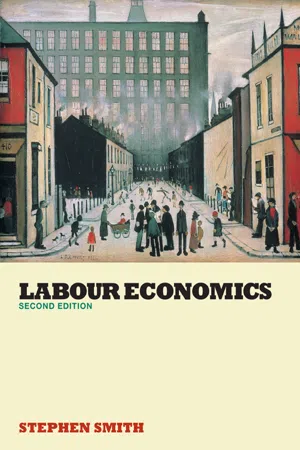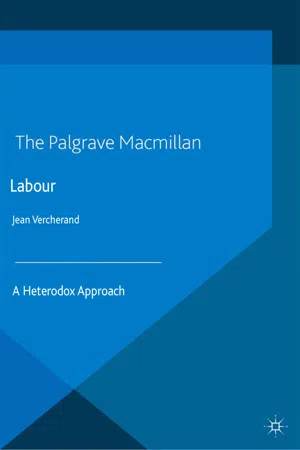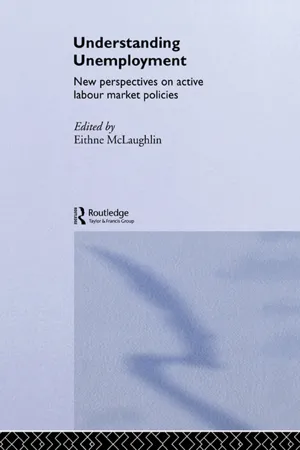Demand for Labour
The demand for labor refers to the quantity of labor that employers are willing and able to hire at a given wage rate. It is influenced by factors such as the productivity of labor, the price of the goods or services being produced, and the availability of alternative inputs. As the demand for goods and services in the economy increases, the demand for labor also tends to rise.
7 Key excerpts on "Demand for Labour"
- eBook - ePub
- Stephen W. Smith(Author)
- 2003(Publication Date)
- Routledge(Publisher)
...2 Labour demand and productivity INTRODUCTION Essentially the Demand for Labour is a derived demand because no firm demands labour for its own sake. Labour is one of the factors of production which firms combine and organise in order to generate output. Consumers demand goods and services which producers seek to supply profitably. Hence they demand labour to help produce goods and services to meet the requirements of consumers. To illustrate the derived nature of labour demand consider the case where a firm expects demand for its products to increase due to greater personal disposable incomes arising from tax cuts. In such circumstances if the extra supply to meet the rising demand is commensurate with the firm’s business plans, then one may reasonably expect that the Demand for Labour will increase. Yet whatever the objective of the firm (profit maximisation, growth, market share, etc.) the decision to employ workers will entail a comparison of the costs and benefits to the firm of doing so. Employing labour gives rise to costs – primarily wages but other costs also exist, national insurance, basic training, etc. The benefit to the firm is mainly the revenue generated by sales of goods/services produced by labour. If the net benefit (total benefit less total cost) is not sufficient then the firm will not employ additional labour or it may lay some workers off. However, it is not necessarily the case that all fluctuations in product demand will result in changes in employment. The firm’s labour demand response to variations in product demand will depend upon the significance and duration of such variations. If a firm is faced with short-run or minor changes in demand for its products then it can counter those fluctuations by adjusting its stocks of unsold goods. Substantial and longer-term changes in demand will induce changes in employment...
- eBook - ePub
Modern Labor Economics
Theory and Public Policy
- Ronald Ehrenberg, Robert Smith, Kevin Hallock(Authors)
- 2021(Publication Date)
- Routledge(Publisher)
...CHAPTER 3 The Demand for Labor The demand for labor is a derived demand, in that workers are hired for the contribution they can make toward producing some good or service for sale. However, the wages that workers receive, the employee benefits that they qualify for, and even their working conditions are all influenced, to one degree or another, by the government. There are minimum-wage laws, pension regulations, restrictions on firing workers, safety requirements, immigration controls, and government-provided pension and unemployment benefits that are financed through employer payroll taxes. All these requirements and regulations have one thing in common: They increase employers’ costs of hiring workers. 1 We explained in Chapter 2 that both the scale and the substitution effects accompanying a wage change suggest that the demand curve for labor is a downward-sloping function of the wage rate. If this rather simple proposition is true, then policies that mandate increases in the costs of employing workers will have the undesirable side effect of reducing their employment opportunities. If the reduction is large enough, lost job opportunities could actually undo any help provided to workers by the regulations. Understanding the characteristics of labor demand curves, then, is absolutely crucial for anyone interested in public policy. To a great extent, how one feels about many labor market regulatory programs is a function of one’s beliefs about labor demand curves. This chapter identifies assumptions underlying the proposition that labor demand is a downward-sloping function of the wage rate. Chapter 4 takes the downward-sloping nature of labor demand curves as given, addressing instead why, in the face of a given wage increase, declines in demand might be large in some cases and barely perceptible in others. Profit Maximization The fundamental assumption of labor demand theory is that firms—the employers of labor—seek to maximize profits...
- eBook - ePub
Modern Labor Economics
Theory and Public Policy
- Ronald G. Ehrenberg, Robert S. Smith(Authors)
- 2017(Publication Date)
- Routledge(Publisher)
...Chapter 3 The Demand for Labor The demand for labor is a derived demand, in that workers are hired for the contribution they can make toward producing some good or service for sale. However, the wages workers receive, the employee benefits they qualify for, and even their working conditions are all influenced, to one degree or another, by the government. There are minimum wage laws, pension regulations, restrictions on firing workers, safety requirements, immigration controls, and government-provided pension and unemployment benefits that are financed through employer payroll taxes. All these requirements and regulations have one thing in common: they increase employers’ costs of hiring workers. We explained in chapter 2 that both the scale and the substitution effects accompanying a wage change suggest that the demand curve for labor is a downward-sloping function of the wage rate. If this rather simple proposition is true, then policies that mandate increases in the costs of employing workers will have the undesirable side effect of reducing their employment opportunities. If the reduction is large enough, lost job opportunities could actually undo any help provided to workers by the regulations. Understanding the characteristics of labor demand curves, then, is absolutely crucial to anyone interested in public policy. To a great extent, how one feels about many labor market regulatory programs is a function of one’s beliefs about labor demand curves. This chapter will identify assumptions underlying the proposition that labor demand is a downward-sloping function of the wage rate. Chapter 4 will take the downward-sloping nature of labor demand curves as given, addressing instead why, in the face of a given wage increase, declines in demand might be large in some cases and barely perceptible in others. Profit Maximization The fundamental assumption of labor demand theory is that firms—the employers of labor—seek to maximize profits...
- eBook - ePub
Media Economics
Applying Economics to New and Traditional Media
- Colin Hoskins, Stuart M. McFadyen, Adam Finn(Authors)
- 2004(Publication Date)
- SAGE Publications, Inc(Publisher)
...Just as the price of a product is determined by supply and demand for the product, the wage rate and employment level for an occupation are determined by the supply and demand for that type of labor. In Figure 12.1, D is the demand curve for labor for a given occupation, S is the supply curve for labor for the same occupation. The equilibrium wage rate is W* and employment level L* where D = S. If the labor market is perfectly competitive, firms will be price takers in the labor market and pay W* for any units of this type of labor employed. Before going any further, we should explain what we mean by the wage rate and the employment level. In common usage, the wage rate is the hourly remuneration for work. But many people are paid a monthly salary. We will use wage rate in a broad sense to indicate the price for hiring labor, whether this is expressed per hour, per month, or per year. The employment level, or number of units of labor used, may be expressed as the total number of hours worked (by all employees) per period (typically a week or month) or as the number of workers used (assuming a typical work week of, for example, 40 hours). Figure 12.1 Market for Labor Occupation Note: D indicates demand for labor; L, units of labor; S, supply of labor; W, wage rate. 12.2 Firm’s Demand for Labor The demand for labor (and for the other factors, land and capital) is a derived demand. Firms do not demand labor for its own sake but as a means to produce goods and services. Given a profit maximization objective, firms will demand labor as long as employing that labor will add more to total revenue than to total cost...
- eBook - ePub
Labour
A Heterodox Approach
- Jean Vercherand(Author)
- 2014(Publication Date)
- Palgrave Macmillan(Publisher)
...In this way, the substitution and output effects that can occur between labour and the other variable factors (intermediate consumptions) are so well integrated upstream in the production of added value that we need no longer worry about them. Since labour is the only variable factor producing added value, all that is necessary is to consider that the notions and value of the average and marginal product curves, mentioned previously, in reality represent average and marginal added values, respectively, so the reasoning developed previously remains unchanged. 7 Hence, if we continue along the same lines, the terms of value of marginal and average product will be used for marginal and average added value, respectively. 2.2 The global Demand for Labour on the market In the case of a factor of production, in this case labour, the global Demand for Labour results from an aggregation process that is more complex than a simple horizontal addition of individual labour curves. 8 However, this difficulty in no way presents an obstacle to the reasoning developed in the following chapters. 3 The equilibrium of the labour market, its modifications and distortions By contrasting these labour supply and demand curves, as they have just been described, it is possible to determine the equilibrium between a wage rate and a volume of labour deemed optimal. For this wage rate, the quantities of labour demanded by companies are exactly equal to those offered by all individuals wishing to work (cf. Figure 2.1 at the beginning of this chapter). Under these conditions, there should be no involuntary unemployment. Thus a contraction of global demand in consumer goods will impact labour demand, and a new balance will be found with a lower wage rate, which again equalises the quantities of labour supplied and demanded. The reverse occurs in the case of an extension of labour demand...
- eBook - ePub
Understanding Unemployment
New Perspectives on Active Labour Market Policies
- Eithne Mclaughlin(Author)
- 2013(Publication Date)
- Routledge(Publisher)
...One of the reasons for giving attention to labour quality is that improved labour supply may provide a way of outflanking the impasse of wage rigidity. Labour quality has considerable importance, over and above its influence on wage fixing, for international economic competitiveness. Appreciation of this has grown during the past decade (Hayes and Fonda 1984 ; OECD 1989a) so that the assertion no longer seems controversial. To compete with other advanced industrial countries, an economy needs considerable powers of innovation, in services as well as in products, and the ability to provide high standards of quality. These competitive characteristics can best be achieved through investment in human resources. Perhaps the most important reason for emphasizing the quality dimension of labour supply is its bearing on equity for individuals. Without an adequate preparation in terms of education and training, individuals will be placed at a disadvantage in relation to both opportunities and to economic hazards during their working lives (see Chapter 4). The Demand for Labour quality Demand for different sorts of labour over the next decade can be assessed partly by extrapolating the established trends and partly by considering the major developments likely to be continuing or taking place over the period. The trends are clear, although it must be emphasized that these represent the interaction of supply and demand rather than demand as such. The 1989 Labour Force Survey (Employment Gazette, 1990a) shows that nearly four-fifths of the employment growth in 1984–9 was attributable to non-manual occupations, and about one-half to what may loosely be called ‘higher’ occupations...
- eBook - ePub
- Ralph Turvey(Author)
- 2022(Publication Date)
- Routledge(Publisher)
...Chapter 7 DEMAND AND SUPPLY IN LABOUR MARKETS DOI: 10.4324/9781003283225-7 A general account of how labour markets work would require a whole book. The aim of this chapter is much more limited. Its purpose is to show, by example, how economic analysis can be used to explain some observed phenomena. First, there is a case study of low pay. Then, two occupations where wage relativities reflect market conditions in an obvious way are briefly considered. Finally, there is an example of an occupation where, in contrast, earnings do not serve to adjust demand and supply and where quality variations appear to play an important role. 7.1. Low paid workers Textiles is an industry whose workers are low paid, and an industry which is declining. It is natural to suspect a connection between these two facts. But first, let us elaborate them a little. The Department of Employment publishes annually the New Earnings Survey, which gives a detailed breakdown of earnings by industry, social class, area and so on. The following figures are abstracted from the New Earnings Survey for 1978. FULL-TIME WORKERS’ AVERAGE GROSS WEEKLY WAGE EARNINGS, 1978 All workers All manual workers Textiles Men £100 £78 £72 Women £59 £48 £46 Hours of work were practically the same. There was, of course, considerable variation around these averages. Thus 10% of all male manual workers earned £58.4 or less, but as many as 22% of textile workers earned less than £55. The industry has been declining for many years, but the rate of decline has probably increased since 1970. The growth of competitors using cheap labour in such countries as Taiwan, Hong Kong, Singapore and even Portugal, together with the longer wearing characteristics of modern man-made fibres are, no doubt, the main reasons...






